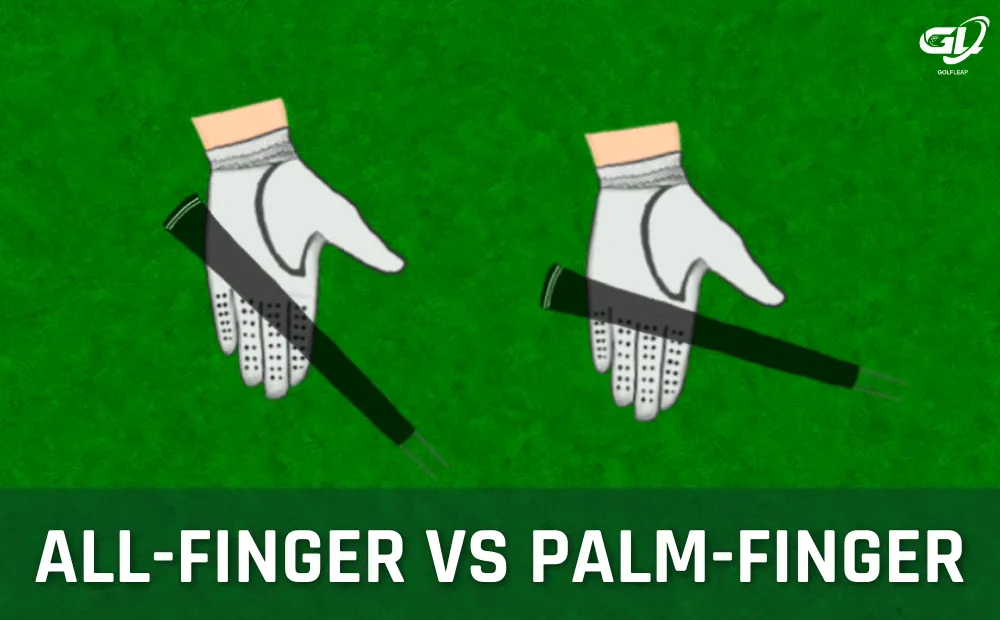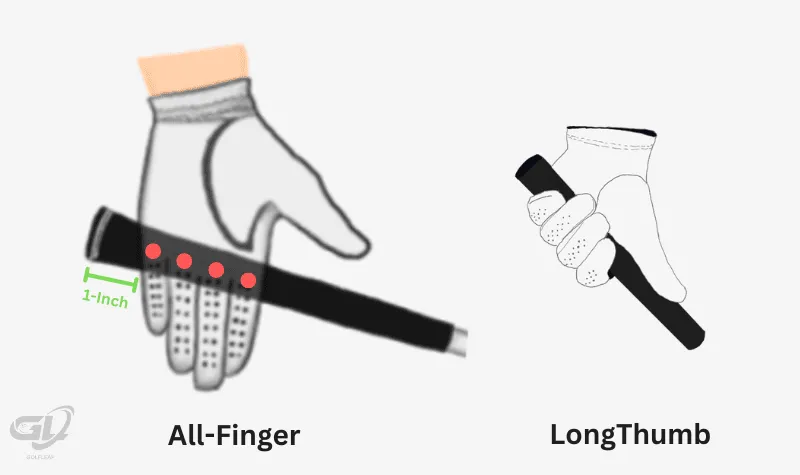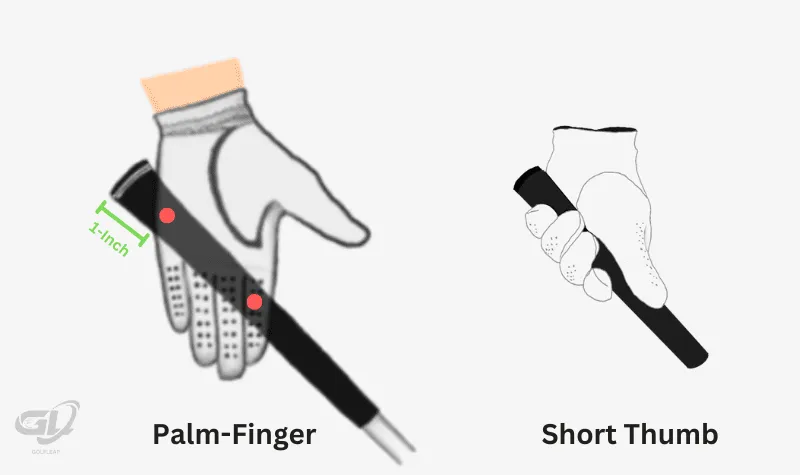
There’s not one way to grip the golf club which includes how the golf grip should fit inside your left hand. When it comes to grip orientation in the left hand, you can either go with the all-finger or the palm-finger golf grip. Both ways of angling the golf grip in your hand have their own sets of pros and cons which we will cover here. Personally, I’m more of a palm-finger grip type of guy!
Table of Contents
All-Finger Golf Grip

The all-finger grip features the grip of the club running across the palm side of your knuckles on the left hand while leaving an inch of the butt of the club ungripped.
When you close the hand, you should feel the upper portion of the grip sitting across the base of your fingers.
Who is the All-Finger Grip For?
Golfers who feel most comfortable with a long left thumb when introducing the left hand onto the grip may want to consider the all-finger grip. This is so the grip doesn’t feel too flimsy when your gripping it with the left hand
Though this is not always the case, it’s definitely based on what you feel most comfortable with and how your swing plane and attack angle react as a result.
Advantages of the All-Finger Grip
In most cases, the all-finger grip makes it easier to maintain or even reduce the angle of the wrist hinge throughout the golf swing. For some, this helps generate that whipping motion we see many good golfers do to generate good club head speed through lag. Additionally, this grip can help those who tend to be too dominant with their right hand before impact helping hit straighter shots.
Disadvantages of the All-Finger Grip
The downside of the all-finger grip is it can make the club lie too low/ too shallow during address which is caused by the additional wrist hinge. This can lead to you hooking your iron shots or simply hitting the balls left of your intended target.
You may suffer from being too ‘wristy’ or even flipping the golf club at impact with the all-finger grip, making it harder to control the club face.
Finally, if you’re a golfer with a larger grip size you may find the all-finger grip uncomfortable.
Palm-Finger Golf Grip

The palm-finger grip features the grip of the club positioned diagonally from the first joint of your index finger to the fleshy part of the palm below your left pinky. Like the all-finger grip, you’ll want roughly an inch of the butt of the club ungripped from the edge of your pinky to the end of the golf grip.
When you close the left hand, you should feel the grip pressure on the base of your index finger and at the low part of your palm that’s below the pinky. However, it’s important to note that this is not where you would be applying the grip pressure on the golf club, but what it should feel like instead. This also applies to the all-finger grip.
Who is the Palm-Finger Grip For?
Most golfers should consider the palm-finger grip as the grip they would use with their left hand. This is the most common grip taught by golf coaches and is likely what you’ll be most used to by now if you’ve had a few lessons already. Plus, if you’re using a left short thumb, this is the grip to go with.
Generally speaking, the palm-finger grip is what you should start with, if it’s not working out, try the all-finger grip instead.
Advantages of the Palm-Finger Grip
The palm-fringer grip is the standard grip we should play with with our left hand. For most golfers, this grip is what would create the best lie angle on the golf ball before and after impact. It helps create more space for your wrist to rotate naturally to square as you make an impact with the golf ball.
Disadvantages of the Palm-Finger Grip
The disadvantage of the palm-finger grip is when the right hand takes over the golf swing which is primarily caused by the orientation the grip and right hand have with respect to your left forearm. This orientation naturally allows the right hand to control the rotation of the wrist along the left forearm more naturally which can lead to errors in casting the golf club too early or introducing more hands on the golf swing. Something we don’t want.
FAQ About All-Finger vs. Palm-Finger
Can I use both grips?
You can use both the all-finger grip and the palm-finger grip if it fits your playstyle. However, in most cases, you’ll be settling for just one grip.
What is the Most Popular Gripping Style Inside Your Hand?
The most popular grip golfers place in their left hand is the all-finger golf grip. It is also the grip that is taught by most golf coaches and the one we recommend.
Summary of the All-Finger vs. Palm-Finger Grip
Regardless if you go with an all-finger or palm-finger golf grip, pick one that feels the most comfortable and ultimately produces the best results. Just remember that these grips only apply to the left hand. The right hand should grip the club differently.
That said, it’s totally fine to alternate around both grip styles to see which is best for you!

